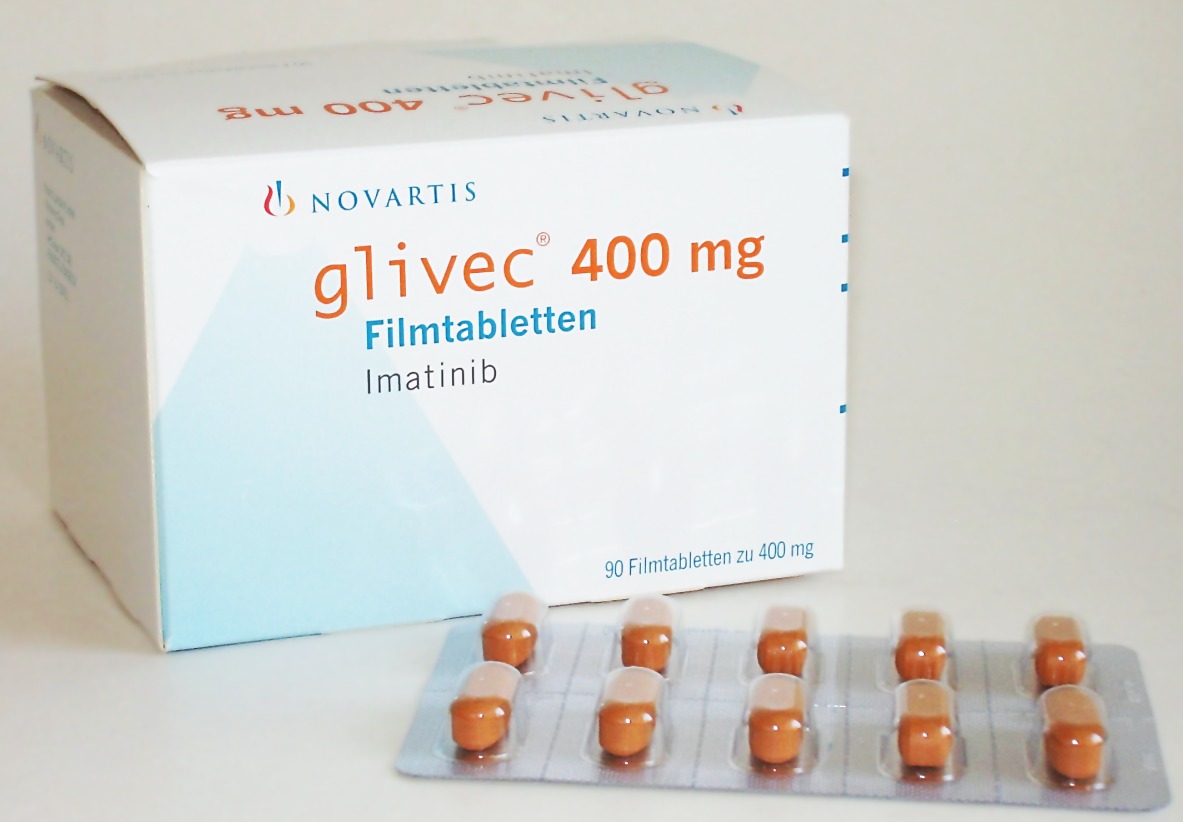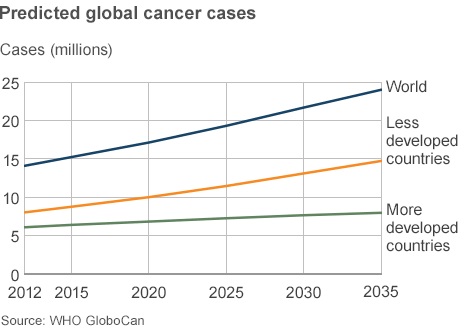Olivia Malvebo
Science News 2014
24 March 2015
Top Cancer-Treatment News of 2014
The world today is a cancer-filled place. More and more people worldwide are being diagnosed with cancer each year. According to the American Cancer Society, in 2014 there were an estimated 1.7 million new cancer cases and 600,000 cancer deaths in the US alone. Cancer remains one of the most common causes of death in the world today. In 2014, however, there have been several discoveries of new successful treatments of different types of cancer.
The problem with most cancer treatments, as Scott Terranella states in an article by ABC News, is that they attack not only cancer cells, but healthy cells, too. Therefore, people usually suffer terrible side effects to these treatments. The patients lose their hair, and grow very thin and weak. Motivated by these side effects, scientists have invented a new drug called Glivec (see Figure 1) that is designed for "molecularly targeted therapy".
 |
| Figure 1. shows the cancer treatment drug Glivec. |
The drug is designed to attack specific cancers based on their molecular structure, which is unique to each type of cancer cell. The drug Glivec is specifically designed to target CML, a rare form of Leukemia. About 7,000 Americans are diagnosed with CML each year. With this form of treatment, a specific drug can be designed for each type of cancer, with little to no effects on healthy cells surrounding it.
Another discovery was made by researchers at the Mayo Clinic in Minnesota, United States. According to an article by Nature World News, "a woman was cleared of an advanced blood cancer after receiving a massive dose of a genetically tweaked measles vaccine" (see Figure 2).
 |
| Figure 2. shows a woman being injected with a dose of tweaked measles vaccine. |
Measles, according to the Oxford Dictionary, is an infectious viral disease causing fever and a red rash, typically occurring in childhood. Experts at the Mayo Clinic genetically designed the measles vaccine to target cancer cells and avoid healthy cells. By doing so, they saved the life of a woman who had been suffering from a severe case of myeloma, a type of blood cancer that affects the bone marrow. This 50-year-old mom, after injected with a massive dose of measles vaccine, was "completely cleared of cancer cells". This case could be a large step forward in the development of effective cancer treatments.
There was also an interesting article by IEEE Spectrum that talks about a new discovery within the art of drug-loaded nano-particles, or in other words, extremely small particles. Prachi Patel, author of the article, says that "delivering drug-loaded nano-particles to tumors is a brilliant way to kill cancer cells and reduce the drugs' side effects". However, these nano-particles can sometimes kill healthy cells as well as cancer cells, which leads to terrible side effects. Researchers at Rice University are now working on a method that will deliver the usual chemotherapy drugs straight inside the cancer cells so that normal cells will not be harmed. They will do this by using lasers to create tiny bubbles around clumps of nano-particles inside the cancer cells. When these bubbles burst, they open small pores so that the drugs that are outside the cell can get inside (see Figure 3).
 |
| Figure 3. shows the process described above. |
By doing this they can "increase drug efficacy while lowering the dosage", says Dmitri Lapotko, head of this research project. This method was up to 30 times more effective than traditional chemotherapy.
Finding more effective methods to cancer treatment is one of the most important tasks at hand in today's society. Cancer is one of the top causes of death around the world. Billions of families suffer both emotionally and economically because of cancer. Treatment is expensive, time is often short, and survival rates are not too high for most types of cancer according to the American Cancer Society. As mentioned earlier, in the US alone, there were 1.7 million new cases of cancer in 2014. That is a single year. And almost 2 million new cases. In one country. This is a serious problem. According to another article by the American Cancer Society, about 1,600 people in the US die from cancer every day. Every day. According to Cancer Research UK, more than 1 in 3 people will develop some form of cancer during their lifetime. The amount of new cancer cases is increasing, and something needs to be done (see Figure 4).
 |
| Figure 4. shows a graph comparing the amount of new cancer cases (in millions) in the World, LDC's, and MDC's per year. |
Based on these statistics, we can conclude that cancer is a major cause of death and tragedy around the world. The number of new cases and deaths are increasing by the minute. More than 1 in 3 people get diagnosed with cancer in their lifetime, and 1 in 4 people will die from it. (see Figure 5).
Today, it is almost unlikely that one will live their entire life without once encountering some form of cancer. This, to me, is scary, and quite frankly, shows me that mankind are weak and defenseless against the will of nature. However, as shown above, during this previous year, we as people have made significant progress within cancer treatment. This provides hope for many people, and sparks new ideas for future treatment of cancer. These news stories are therefore some of the most important of the year 2014. Without signs of new treatment possibilities, people would lose hope, and cancer would become an even bigger problem than it already is.
 |
| Figure 5. ...1 in 3 people get diagnosed with cancer during their lifetime, and 1 in 4 people will die from it. |
Today, it is almost unlikely that one will live their entire life without once encountering some form of cancer. This, to me, is scary, and quite frankly, shows me that mankind are weak and defenseless against the will of nature. However, as shown above, during this previous year, we as people have made significant progress within cancer treatment. This provides hope for many people, and sparks new ideas for future treatment of cancer. These news stories are therefore some of the most important of the year 2014. Without signs of new treatment possibilities, people would lose hope, and cancer would become an even bigger problem than it already is.
No comments:
Post a Comment
Note: only a member of this blog may post a comment.